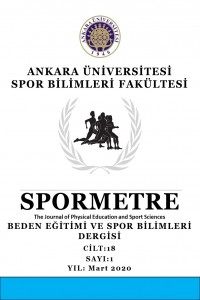Araştırma Makalesi
INVESTIGATION OF THE INTESTINAL FLORA FROM THE RUMİNOCOCCACEAE FAMİLY IN SPORTSMEN AND SEDENTARY MEN
Öz
Abstract:In this study, it was aimed to investigate the intestinal flora from the Ruminococcaceae family in sportsmen and sedentary men.In total, 17 subjects between the ages of 18-24 participated voluntarily in the study including 10 men who had training regularly and played football at an elite level and 7 physically non-active (sedentary) men. The subjects continued their routine eating habits. In the study, "fecal sample" was taken from all the groups once and the Ruminococcaceae family was analyzed metagenomically through the New Generation Sequencing Method and Illumina MiSeq analyzing device. Minitab 17 and SPSS 20.0 (Statistical Package for the Social Sciences) package software were used for the statistical analyses of the findings and the significance level was taken as p<0.05.It was discovered that elite sportsmen had more intestinal floras from the Ruminococcaceae family compared to the sedentary individuals and this difference was statistically significant (p<0.05).It can be said that exercise affects the Ruminococcaceae family positively by causing an increase in this family. In future studies, we suggest the investigation of the factors such as lifestyle, nutritional style and medication, which also influence the internal flora.
Anahtar Kelimeler
Kaynakça
- Allen, J. M., Berg Miller, M. E., Pence, B. D., Whitlock, K., Nehra, V., Gaskins, H. R., White, B.A., Fryer, J.D, and Woods, J. A. (2015). Voluntary and forced exercise differentially alters the gut microbiome in C57BL/6J mice. Journal of Applied Physiology, 118(8), 1059-1066.
- Bressa, C., Andrino, A.B., Santiago, J.P., Soltero, R.G., Perez, M., Lominchar, M.G., Mate ´-Muñoz, J. L., Domı´nguez, R., Moreno, D., and Larrosa, M. (2017). Differences in gut microbiota profile between women with an active lifestyle and sedentary women. Plos One, 12(2), 1-20.
- Chaves,F.M.,Baptista,I.L.,Simabuco,F.M.,Quaresma,P.G.F.,Pena,F.L.,Bezerra,R.M.N.,Pauli,J.R.,Cunha,D.T.,Campos-Ferraz,P.L., and Antunes, A.E.C. (2018). High-intensity-exercise-induced intestinal damage is protected by fermented milk supplemented with whey protein, probiotic and pomegranate (Punica granatum L.). British Journal of Nutrition, 119, 896–909.
- Codella, R., Luzi, L., and Terruzzi, I. (2017). Exercise has the guts: How physical activity may positively modulate gut microbiota in chronic and immune-based diseases. Digestive and Liver Disease, 1-48.
- Çağlayan Tunç, A.(2019). Beslenme ve Obezite.İstanbul.Güven Plus,58.
- Genç, A., Çağlayan Tunç, A. (2020). Examination of Obesity Awareness Levels of Physical Education Teacher and Coaching Education. Journal of Education and Training Studies,8(2),24-28.
- Junger A. (2018). Clean intestine.İstanbul: Pegasus Publishing, 30-62.
- Liu, Z., Liu, H.Y., Zhou, H., Zhan, Q., Lai1, W., Zeng, Q., Ren, H., and Xu, D. (2017). Moderate-intensity exercise affects gut microbiome composition and influences cardiac function in myocardial infarction mice. Frontiers in Microbiology, 8, 1-11.
- Mayer E. (2017). Brain-Intestine Connection (Third Edition).İstanbul: Paloma Publishing, 24-45.
- Mach, N., and Fuster-Botella, D. (2017). Endurance exercise and gut microbiota: A review. Journal of Sport and Health Science, 6(2), 179-197.
- Mika, A., Fleshner, M. (2016). Early-life exercise may promote lasting brain and metabolic health through gut bacterial metabolites.Immunology and cell biology,1-9.
- Monda, V., Villaono, I., Messina, A., Valenzano, A., Esposito, T., Moscatelli, F., Viggiano, A., Cibelli, G., Chieffi, S., Monda, M, and Messina, G. (2017).Exercise Modifies the Gut Microbiota with Positive Health Effects. Oxidative Medicine and Cellular Longevity,1-8.
- Nazlıkul H. (2018). The emotional brain: Intestine.İstanbul:DestekPublishing,15-50.
- Panasevich, M. R., Morris, E. M., Chintapalli, S. V., Wankhade, U. D., Shankar, K., Britton, S. L., Koch, L.G.,Thyfault, J.P., and Rector, R. S. (2016). Gut microbiota are linked to increased susceptibility to hepatic steatosis in low-aerobic-capacity rats fed an acute high-fat diet. American Journal of Physiology-Gastrointestinal and Liver Physiology, 311(1), 166-179.
- Starkel, P.,Lecrercq, S.,Delzenne, N. M., Timary, P. Alcohol-Dependence and the Microbiota-Gut-Brain Axis. The Gut-Brain Axis Dietary, Probiotic, and Prebiotic Interventions on the Microbiota. Elsevier,363-379.
- Stojanovic,M.R., and Vos,W.M. (2014).The first 1000 cultured species of the human gastrointestinal microbiota.FEMS Microbiology Reviews, 38, 996–1047.
- Queipo-Ortuno, M. I., Seoane, L.M., Murri, M., Pardo, M., Gomez-Zumaquero, J.M., Cardona, F., Casanueva, F., Tinahones, F.J. (2013). Gut microbiota composition in male rat models under different nutritionalstatus and physical activity and its association with serum leptin and ghrelin levels. Plos One, 8, e65465.
- Wang, F., Li, Q., Wang, C., et al. (2012). Dynamic alteration of the colonic microbiota in intestinal ischemia-reperfusion injury. Plos One,7, e42027.
- Yılmaz, Ö.A. (2015). Yaşlılarda sağlıklı beslenme – Probiyotikler. Ege Tıp Dergisi, 54, 16-21.
Toplam 19 adet kaynakça vardır.
Ayrıntılar
| Birincil Dil | İngilizce |
|---|---|
| Konular | Spor Hekimliği |
| Bölüm | Araştırma Makalesi |
| Yazarlar | |
| Yayımlanma Tarihi | 17 Mart 2020 |
| Yayımlandığı Sayı | Yıl 2020 Cilt: 18 Sayı: 1 |
Spormetre Journal of Physical Education and Sport Sciences licensed under a Creative Commons Attribution-NonCommercial-Non-Derivatives 4.0 International Licence (CC BY-NC-ND 4.0).

